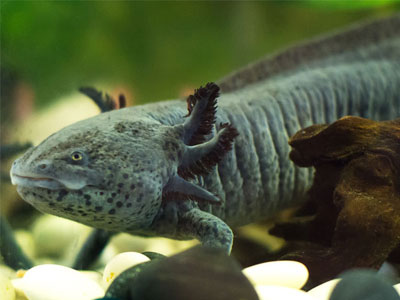
While not the most common aquatic pet, axolotls have gained quite a lot of popularity in recent years, especially since being featured as aww-inducing pets on social media platforms.
Axolotls are an amphibian species and part of the salamander family, but here’s a twist: Despite developing legs, axolotls remain aquatic for their entire life, very much unlike other salamanders.
In the wild, axolotls are unfortunately headed for extinction. The only remaining population can be found in Lake Xochimilco, Mexico.
While definitely a cute choice for a pet, they do have special keeping requirements that you must prepare for in order to offer them the best living conditions and ensure they stay healthy and happy in their environment.
In this article, I’m going to walk you through everything you need to know about caring for axolotls including their aquarium requirements, feeding requirements, lighting requirements, and other aspects related to their care.
Aquarium Size for Axolotls

If axolotls have won over your heart too, it’s no wonder — they have cute wide eyes, four thin legs, they come in many different color morphs, and filament-lined gill stalks that stick out from the back of their heads.
However, it’s important to know that axolotls can grow to become as big as 30 cm, which means they require plenty of aquarium space.
How much exactly? Most experts recommend a 15-20 gallon aquarium and this for a single axolotl, since they’re quite the messy creature that requires a good tank cleaning regimen.
You can fill the aquarium to the depth of your choice but filling it as you would for a normal fish tank is better since you’ll have an easier time keeping water parameters right.
A land area isn’t needed for axolotls since they don’t emerge from the water and it would go unused, but a substrate is needed, although any substrate won’t do.
Some substrates can be extremely damaging to axolotls. Take gravel for example. Since axolotls feed by sucking in water, small pieces of gravel could be ingested causing life-threatening gut issues like bowel-obstruction.
You could go with a no substrate version, but I do recommend adding some substrate to help your axolotls grip the surface of your tank and walk properly, thus avoiding potential distress.
I recommend using sand, since sand particles are small enough not to cause problems if ingested and offer enough traction to axolotls to avoid causing them distress.
Male to Female Axolotls Ratio
Axolotls aren’t the most social animals and keeping more axolotls together won’t benefit them. In fact, juvenile axolotls are known to be cannibalistic towards each other and even adults will nip each other’s feet or gills.
Keeping them with other aquatic creatures is not a good idea either because if they’re too small, the axolotls will eat them, if they’re too big, they may nip the gills and feet of axolotls causing their demise.
If you are keeping more than one axolotl in a single aquarium, make sure the aquarium is large enough for them to stay out of each other’s way. If you notice signs of cannibalism, do make sure to separate them.
While axolotls can grow back or regenerate their body parts, aggressive tendencies should not be permitted or encouraged.
What if you want your axolotls to breed?
Having one female and one male axolotl will usually do the trick but do be prepared that they won’t breed when you want them to, but when they’re ready. Also be prepared that a female axolotl can lay up to 1000 eggs.
You shouldn’t allow axolotls to breed before 18 months of age, since they’re still growing and breeding can put a lot of stress on the female axolotl’s body and shorten her lifespan.
Some experts advise that keeping axolotls separate before breeding and attempting breeding from December to June is usually more successful.
In summary, if you don’t want your axolotls breeding, it’s best if you keep only axolotls of the same gender. It’s also better to keep them separate as they may not get along with each other.
Since there isn’t any benefit in keeping them in a community, you can keep a single axolotl and provide it with the best possible conditions, so you can enjoy their company for a long time.
Axolotls have a life expectancy of 10 to 20 years, so if you follow my advice on how to care for axolotls, you can maximize their life expectancy.
Water Parameters for Axolotls
Optimal water conditions are vital for axolotls. Before adding axolotls to your aquarium, make sure the tank is cycled properly to avoid ammonia poisoning.
Axolotls have specific water parameter requirements as follows:
Water Temperature
The temperature in the axolotl tank should be kept stable in the range of 57 and 68 degrees Fahrenheit (14 and 20 degrees Celsius). Water temperature should never exceed 75 F (24 C).
Temperatures above and below their accepted range can put serious stress on them leading to infections and other diseases, and even death.
Water PH
Another water parameter that should be kept stable is water pH. Axolotls thrive in water with a pH of 7.40-7.60. Axolotls can tolerate water with a pH in the range of 6.5-8.0, but you should strive for the ideal parameters and keep the pH stable.
Water Hardness
Axolotls thrive in and are better adapted to hard water conditions. Although soft water can be tolerated, it can lead to anemia and discoloration, therefore, I recommend you check your water hardness and adjust water hardness appropriately.
Water Flow
Axolotls don’t enjoy having a water current in their tank; therefore, you should set the filter to a gentle setting to avoid stressing out your axolotl.
Maintaining Axolotl Tank
I mentioned that axolotls have a high bio-load, which means, you must up your tank maintenance game to dilute and wash away toxins that can harm your pet.
Having a water filter sure helps, but experts also recommend performing weekly 20% water changes to further remove toxins and replenish the water and siphon the substrate.
As I mentioned, strong filter currents must be avoided. Still a water filter is beneficial, and I advise you to get one for your tank.
In the absence of a water filter, you’ll need to perform daily water changes, which may be difficult if you don’t have the time for it.
When performing water changes, make sure to remove chlorine and chloramine, both commonly available in tap water and both highly toxic to axolotls.
Feeding Your Axolotls
Axolotls thrive on a carnivore diet, they’re diet is entirely meat-based, therefore, if you’re planning on keeping axolotls, you must know what meaty foods you can feed them.
Axolotls that live in the wild eat insects, small fish, crustaceans, snails, worms, and any other small animals that fit their mouths and that can be found in Mexican lake waters.
In captivity, you can feed your axolotls a variety of meaty foods including large earthworms, blackworms, bloodworms, and the occasional frozen shrimps, prawns, mealworms, tuna, and lean meats such as chicken or beef.
When it comes to food, axolotls are weird. They’ll eat until full and will pass on food if they’re still full from previous servings.
Growing axolotls should be fed daily, while adult axolotls can go without food up to two weeks, but you should never leave them without food for more than three days.
Feeding them every 2-3 days is enough for them. You don’t want to overfeed axolotls because they can become constipated, which in turn can cause bowel obstruction, often resulting in their death. Make sure you scoop out any uneaten food, so it won’t foul the water.
Once you get accustomed to axolotls, you’ll quickly figure out how much and how often do they like to eat.
Like other salamanders, axolotls don’t develop mineral or vitamin deficiencies, and don’t require supplementation with these types of nutrients.
Water Filtration for Axolotls
A water filter may not be required for axolotls if you’re willing to make very frequent (daily) water changes, but since most hobbyists don’t have the time, they’ll choose to have a water filter.
Axolotls excrete a lot of waste, so you must clean their tanks often to remove and wash away toxins. A filter can go a long way in keeping water parameters at optimal levels.
When choosing a water filter for your axolotl, you must make sure that it’s sized appropriately for the water volume that needs filtering.
However, you should also avoid filters that create a strong current in the tank since axolotls can’t tolerate it and strong aquarium currents is one of the major causes of stress-related diseases in axolotls.
Your filter should offer biological and chemical filtration. You can check out the hang-on-back filters or small canister filters of brands such as Fluval, Eheim or Penn Plax.
You may need to disperse the outflow from your filter with a spray bar to avoid creating strong currents in the aquarium.
Cooling Water for Axolotls Tank
I mentioned how axolotls enjoy cooler water and how higher water temperature or even unstable temperatures can cause have devastating effects for the health and well-being of your axolotl.
You should keep their water temperature below 68 F (or 20 C) and remember that cooler temperature is not nearly as bad as temperatures higher than their accepted range.
Therefore, cooling the water in an axolotl tank can become a problem if you live in a region with hot climate throughout the year.
First, you’ll need an aquarium thermometer to monitor the water temperature in the aquarium. I advise getting one that can read both the air temperature and the water temperature at the same time.
Secondly, you will have to keep your axolotl tank in a cool place. If you have a basement or a lower level in your home, go for that instead of the upper levels.
In no case should you expose your axolotl to direct sunlight, choose a part of the home that doesn’t get much or any sunlight. Keep the tank away from electronics that emit heat.
Next, having an air-conditioned room is one way to help keep the temperature low, but do make sure you monitor the water temperature to avoid turning the water too cool.
In the absence of air conditioning, ice cubes and ice bottles are another way to keep the water from warming up.
Don’t put the entire ice bottle into the water, keep the bottle mostly out of the water in a corner of the tank. Once it’s thawed out, you’ll need to replace it, while also avoiding temperature fluctuations.
I also recommend avoiding using lighting that emits heat which can also heat the tank, undermining your efforts to keep water at a cool temperature.
As you can see, keeping the water temperature stable and in the ideal range for axolotls is difficult, especially if you live in a hot climate zone or temperatures in the summer rise too mu
Artificial Light for Axolotls
Axolotls do not require any specific lighting conditions and they’re accustomed to low-level lighting since that’s what’s specific for their natural habitat as well.
In fact, strong bright lights will cause distress since axolotls don’t have eyelids. I recommend using only decorative lights that should be dimmed and setting up hiding spaces and decorations for your axolotl to hide.
If you notice any signs of distress, make sure you further adjust your lights.
Can You Pet Axolotls?
I get it. They’re cute, they really are. And you might want to pet them and hold axolotls in your hands. Well, you shouldn’t. Here why:
Axolotls are display pets. And display pets only. They can’t interact with their owners outside of the tank and they should not be handled unless absolutely necessary.
They have delicate, soft bodies and permeable skin, and you shouldn’t take them in your hands or pet them.
How Long do Axolotls Live For?
Axolotls can live a long life if they’re cared for properly and fed a healthy diet. They can live up to 20 years, but most will have a lifespan between 10 to 20 years.
Unfortunately, there are a few diseases and illnesses that can shorten their lifespan. Here are some common diseases that affect axolotls:
Stress
Stress is one of the most common causes of disease in axolotls. There are many stress factors such as strong water current, nippy tank mates, untreated water, warm water, etc.
If stressed, axolotls may lose their appetite, you may notice their tails curling, and their gills are turning forward.
Injury
Nippy tank mates are a common cause of injury for these amphibians, but axolotls have a remarkable ability to regenerate limbs and injured gills.
Therefore, with injuries, the biggest concern are infections. Exposed wounds can quickly become infected, hence another reason why it’s important to keep their tanks clean.
Obstruction
Bowel obstruction can happen if axolotls ingest gravel, which will then cause obstruction in their GI tract. Constipation can also cause obstruction, and this is the reason why you should only feed them every 2-3 days.
If your axolotl is refusing to eat for multiple days, is bloated, and has a low waste production, the cause is very likely an obstruction.
Fridging your axolotl can help eliminate the cause of obstruction and help your axolotls recover faster.
Floating Axolotls
Axolotls are able to float at will, but if you notice your amphibian being unable to return to the bottom of the tank, floating up against their will, floating too often or appearing distressed, the problem could be air trapped in the GI tract. Fridging can be a solution to this issue as well.
Do Axolotls Jump Out from Tank?
Yes, axolotls do jump out of their tanks, so having a lid on the tank or an aquarium hood is important to prevent them from jumping.
And since we’re on the topic of being out of the tank, I must warn you that you shouldn’t keep axolotls out of water.
You may have heard that the axolotl can undergo metamorphosis into a terrestrial from just like salamanders and frogs do, but the conditions in which this happens in nature is poorly understood.
You should not attempt to induce metamorphosis in your axolotl as this can stress it out and significantly shorten its lifespan.
Conclusion
Axolotls are an interesting aquarium pet with very specific requirements that must be met. They’re sensitive to unstable temperatures and they produce quite a lot of waste, so you must be on top of your tank cleaning game to ensure water parameters are right.
Minimizing stress, avoiding overfeeding, and ensuring optimal water and tank conditions are crucial for their wellbeing.
Axolotl also don’t mind being kept alone in a tank, in fact they do great on their own since they aren’t very social creatures and tend to engage in nipping when kept together with other axolotls.
I hope you have found this axolotl care guide helpful and having read it, you are now better equipped to offer proper care for your axolotl.

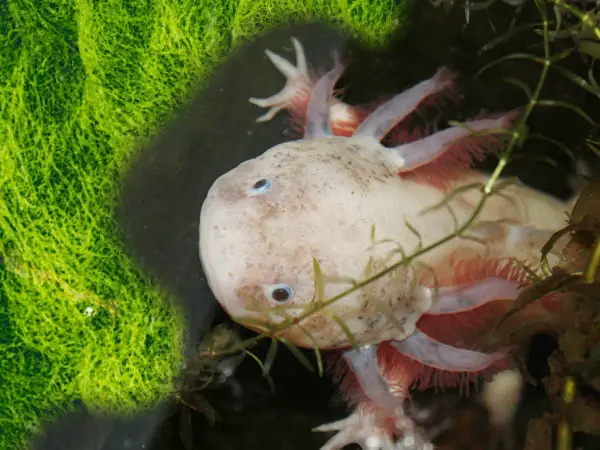
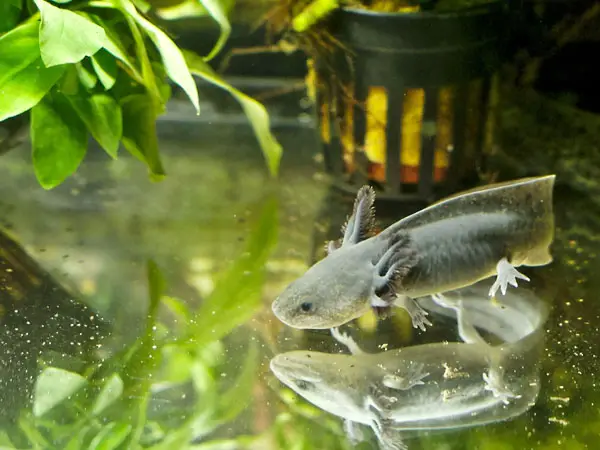
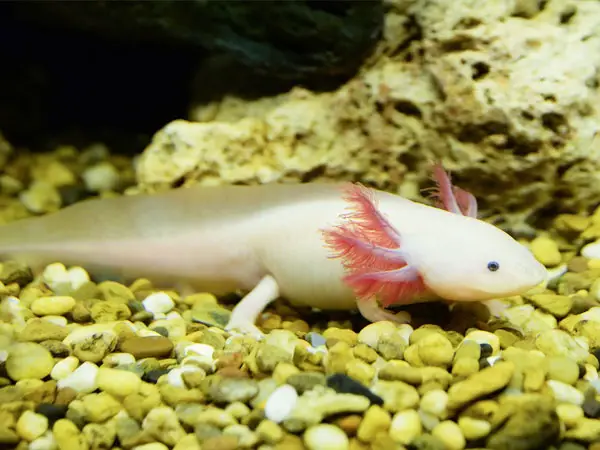
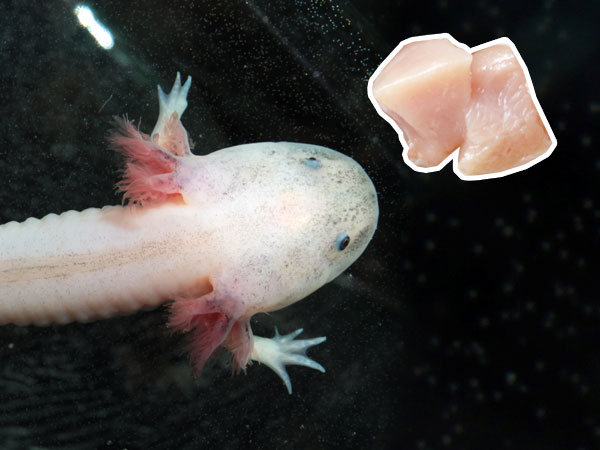
Can you suggest what kind of live plants are okay for my Axolotl?
You can keep various aquatic plants with your axolotl, such as: anubias, java fern, java moss, amazon frogbit, marimo moss ball, riccia, vallisneria and other plants that your axolotl can’t break. Plants with soft stem or leaves are not suitable, because axolotls will damage the plants in such way, that they can’t regenerate and will die.
Hello, I was curious if the Tropica Soil substrate would be good for Axos, they have a fine one and I sue it for shrimp and honestly one of the best substrates, just have trouble finding an answer for it, and I noticed on of your images had an Axie on a substrate that looked similar.
Hey! Some people reported the Tropica Soil can break down overtime, while others say it will last a long time.
The substrate in the picture is JBL Manado as far as I know. To answer you question: you can try out Tropica Soil in axolotl tank, but I would rather use sand, because it is cheaper and safer for axolotls.
Hi! I wanted to ask, why my axolotls change color. It happens about once a year and they go from black/gray to white. I couldn’t find anything about that on the internet so I’m curious.